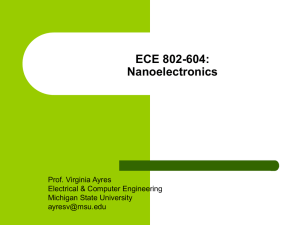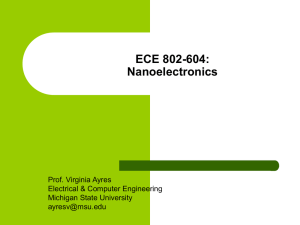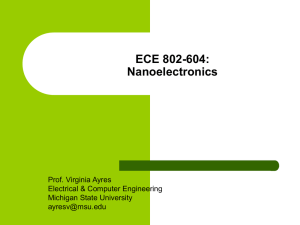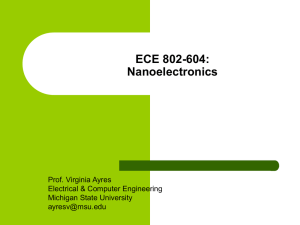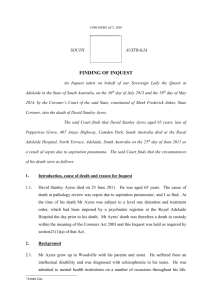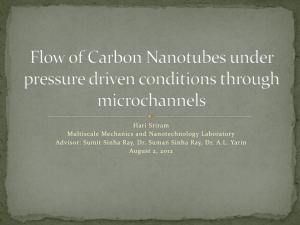Lecture 24 21 Nov 13 - Michigan State University
advertisement
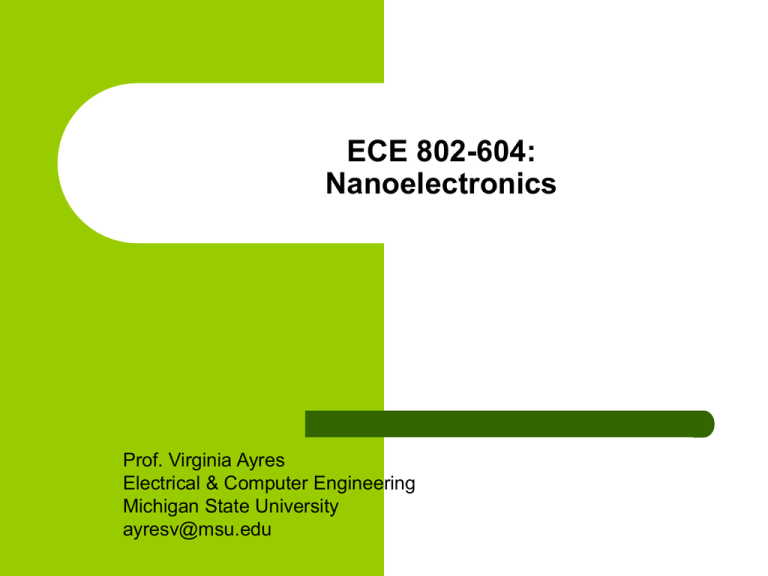
ECE 802-604: Nanoelectronics Prof. Virginia Ayres Electrical & Computer Engineering Michigan State University ayresv@msu.edu Lecture 24, 21 Nov 13 Carbon Nanotubes and Graphene CNT/Graphene electronic properties sp2: electronic structure E-k relationship/graph for polyacetylene E-k relationship/graph for graphene E-k relationship/graph for CNTs R. Saito, G. Dresselhaus and M.S. Dresselhaus Physical Properties of Carbon Nanotubes VM Ayres, ECE802-604, F13 VM Ayres, ECE802-604, F13 VM Ayres, ECE802-604, F13 VM Ayres, ECE802-604, F13 Graphene: Real space Reciprocal space VM Ayres, ECE802-604, F13 VM Ayres, ECE802-604, F13 CNT Unit cell in green: C h = n a1 + m a2 |Ch| = a√n2 + m2 + mn dt = |Ch|/p cos q = a1 • Ch |a1| |Ch| T = t1 a1 + t2 a2 t1 = (2m + n)/ dR t2 = - (2n + m) /dR dR = the greatest common divisor of 2m + n and 2n+ m N = | T X Ch | | a1 x a2 | = 2(m2 + n2+nm)/dR VM Ayres, ECE802-604, F13 VM Ayres, ECE802-604, F13 VM Ayres, ECE802-604, F13 For a (4,2) CNT: VM Ayres, ECE802-604, F13 Reciprocal space (4, 2,) CNT Graphene Real space T C VM Ayres, ECE802-604, F13 K1 is in same direction as Ch Specify direction of Ch using choral angle K2 is in same direction as T Ch is the diameter direction VM Ayres, ECE802-604, F13 CNT Unit cell in green: C h = n a1 + m a2 |Ch| = a√n2 + m2 + mn dt = |Ch|/p cos q = a1 • Ch |a1| |Ch| T = t1 a1 + t2 a2 t1 = (2m + n)/ dR t2 = - (2n + m) /dR dR = the greatest common divisor of 2m + n and 2n+ m |T| = √ 3(m2 + n2+nm)/dR = √ 3|Ch|/dR N = | T X Ch | | a1 x a2 | = 2(m2 + n2+nm)/dR VM Ayres, ECE802-604, F13 K1 is in same direction as Ch Specify direction of Ch using chiral angle K2 is in same direction as T Ch is the diameter direction Can only fit an integral number of ewavelengths around the diameter Can only fit an integral number of ewavenumbers K1 around the diameter VM Ayres, ECE802-604, F13 VM Ayres, ECE802-604, F13 (4,2): 0 through 27 28 of these: VM Ayres, ECE802-604, F13 In blue box: a unit vector in the K2 direction The K2 direction is the same as T: along the length of the CNT k is continuous so this is an E-k relationship. k depends on (n,m) VM Ayres, ECE802-604, F13 CNT E-k; Energy dispersion relations (E vs k curves): Quantization of Energy E is here Quantization of ewavefunction by m in Ch / K1 direction k is continuous In T/ K2 direction VM Ayres, ECE802-604, F13 CNT E-k; Energy dispersion relations (E vs k curves): VM Ayres, ECE802-604, F13 Energy dispersion relations (E vs k curves) for a CNT: Example: How many E vs k curves are there for the (4,2) CNT? VM Ayres, ECE802-604, F13 Energy dispersion relations (E vs k curves) for a CNT: Answer: 2N = N x E+(k) + N x E-(k) VM Ayres, ECE802-604, F13 Graphene: the 6 equivalent K-points Bottom of the conduction band the 6 equivalent K-points metallic E ky kx This factor slices the graphene Eg2D VM Ayres, ECE802-604, F13 Consider (4,2) CNT: m=9 VM Ayres, ECE802-604, F13 Near a K- point = metallic: VM Ayres, ECE802-604, F13 Condition for hitting a K-point: VM Ayres, ECE802-604, F13 Consider a (n, n) armchair CNT: VM Ayres, ECE802-604, F13 Consider a (n, n) armchair CNT: (n, n) armchair CNTs are all metallic: n VM Ayres, ECE802-604, F13 Consider a (n, 0) zigzag CNT: (n, 0) zigzag CNTs are metallic when n is a multiple of 3. 0 VM Ayres, ECE802-604, F13 Consider a (n, 0) zigzag CNT: Example: metallic or semiconducting? (9,0) = ? (10,0) =? 0 VM Ayres, ECE802-604, F13 Consider a (n, 0) zigzag CNT: Answer: (9,0) = metallic (10,0) = semiconducting 0 VM Ayres, ECE802-604, F13 General Energy dispersion relations (E vs k curves) for a CNT: VM Ayres, ECE802-604, F13 Consider an (n, n) armchair CNT. You can write a periodic boundary condition on kx and substitute into eq’n 2.29. That leaves just ky as open, MD calls it just k. VM Ayres, ECE802-604, F13 VM Ayres, ECE802-604, F13 Consider an (n, 0) zigzag CNT. You can write a periodic boundary condition on ky and substitute into eq’n 2.29. That leaves just kx as open, MD calls it just k. VM Ayres, ECE802-604, F13 VM Ayres, ECE802-604, F13 Example: Zigzag: (n,0) What is the condition on n from this E-k diagram? VM Ayres, ECE802-604, F13 Answer: Zigzag: (n,0) Diagram shows its metallic: n is a multiple of 3 VM Ayres, ECE802-604, F13
